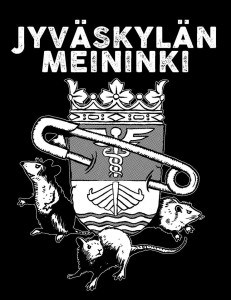 (A German speaking version of this interview was first published in Trust Fanzine #183.)
(A German speaking version of this interview was first published in Trust Fanzine #183.)
Somehow this is the second part of my brief portrait on the DIY and punk scene in Jyväskylä, Finland. ‘Somehow’ because this here is going to be an interview and no monologic report. But, who will be interviewed? For that, a short version of how we got here:
I was waiting at that glade since an hour or so. One of the local punks in Jyväskylä told me the other day during midnight-dusk, if I would wait 1-2 hours at one spot, it would be pretty likely to encounter some wild animals. – But: nothing. No peep whatsoever. Was it naive to think that one would find here a perfect idyll? That perhaps a moose would cross my way or some weasel? That it perhaps by night – under the Northern Lights – would stand in front of me and I – in shock and awe – would say: „Wow!“? – Instead: all mooses are dead. Apparently. These animals are more and more migrating to Brandenburg now, I heard, and remembered a rather trivial report from a small town’s newspaper right at the boarder to Poland.
The sound of an incoming text message immediately disrupted the silence, which from time to time was only disrupted by the roar of an Off-Road-Motorcycle far away, mingling itself together with the grey in grey daylight. It was Olli. The same local punk who told me that in Finland you might be able to actually see animals in the wild. Pah! He wrote: „Look, you wanted to know how it is with punk and everything here in and around Jyväskylä. There is this guy, Mikko, who is currently working on a documentary about this whole stuff. The documentary is planned to be released in October 2016. With him you can talk for hours about that. Here his number.“
No sooner said than done! A few days later Mikko and I were sitting in the „Musta Kynnys“ („The Black Threshold“). We were drinking bad and expensive beer and were talking about his documentary on punk and DIY in Jyväskylä, on which he was still working togehter with other friends at that moment. The name of the project: „Jyväskylän Meininki: A Punk Documentary“. Back then (somewhere in the Finnish late summer) the movie had not been released yet and just for the feeling I did not record anything from our conversation in the bar (typical…). That’s why we did the whole thing again in the end of 2016 (wind in Germany – winter in Finland) via e-mail. Anyway, by the end of 2016 I was already able to watch the movie in the original Finnish with perfectly made english subtitles. The former questions, of course, changed a little bit after seeing it and the final results you are now able to read here:
Hei Mikko! Jyväskylän Meininki is a punk documentary about a city in center Finland named Jyväskylä. Maybe let’s start here: Why Jyväskylä? Why a punk documentary about that particular city?
Jyväskylä was the obvious choice for a bunch of reasons, really. Firstly there was the close connection I’ve had to the scene of Jyväskylä for a period of over ten years or so now, which has brought me close to the subject and therefore enabled me to know a lot of the people involved and maybe given me an insight on what to ask about specific events and topics in the history of the scene that might have not come up without that kind of a personal connection. So Jyväskylä was the obvious and the easy choice for a documentary topic, but it had a strong personal attachment to it also. The movie was, in a large sense, an attempt to give something back to the people of Jyväskylä, to the scene in and around it, who had over the years helped me a lot in determining my ideological growth and positive sense of the world, so in a way I treated the movie like a testament of sorts to these people. Also Jyväskylä has been, from my perspective, criminally overlooked when considering the various documentations made on the the history of Finnish punk. Even though the history, or parts of it at least, has been told by various film makers and authors, I have never seen or heard a mention of Jyväskylä in any of these works, which strikes me as odd, since there has been a good bunch of bands coming from this area that have influenced punk and hardcore not only in Jyväskylä or Finland, but even on global scale. So I knew there was a lot of untold stories here and I had a strong sense of doing one for the home team, making it all about us, about our history and our music and our people and their experiences and views on life, which is really the center of the story.
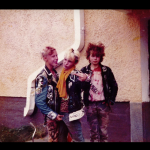 What would you say is the broader purpose or use of ‘Jyväskylän Meininki’? Perhaps also for other punk communities in other cities abroad? Why punk documentaries today? Isn’t everything told? 😉 Really the broader purpose of this documentary is to act as an catalyst in a larger cultural revolution, to put it poetically. We have seen for decades that there can exist art outside of the business orientated machinery, uncompromising and often vastly more interesting art, one that thrives from a want or a need to express one self, to communicate something without the financial angle playing any part of it. We have seen and come accustomed to this especially in the punk scene, where records and shows and tours are done DIY by a standard almost. I strongly feel this is possible with movies also, and I’m after a reality where the passive part of the “art consumer“ fades away and we all start taking a part in securing the continuity of interesting music and art and books and movies done by ourselves, outside of the industries, telling our own stories. A big part of the work we’ve done since the release of the movie is trying to get the message out there that we can totally do these on our own, especially these days, when the technology enables you to basically do a movie with your phone and a laptop. There isn’t anything magical about it, it isn’t preserved to “certain types of people“, we can all do it and get the word out there without the help of commercial TV or monopolistic cinemas or any of the traditional machinery involved, and this movie (and this interview too) is a living example of it, I feel. And no, I don’t feel like everything has been told. 🙂 Surely these kind of punk documentaries, even the ones depicting a scene of a certain city, have been done before, but like I said earlier, we have had a lot of unsung heroes and stories here that were captured on camera basically for the first time. And even as the documentary touches certain topics that have certainly been told before, such as “what is punk and what does it give to you?“, the outcome and what you take from it always depends a lot on the perspective of the person who experiences and vocalizes it, so even if the topics and the feelings within them are familiar, the answers are unique and personal, while also having a relatable and a universal sense to them.
What would you say is the broader purpose or use of ‘Jyväskylän Meininki’? Perhaps also for other punk communities in other cities abroad? Why punk documentaries today? Isn’t everything told? 😉 Really the broader purpose of this documentary is to act as an catalyst in a larger cultural revolution, to put it poetically. We have seen for decades that there can exist art outside of the business orientated machinery, uncompromising and often vastly more interesting art, one that thrives from a want or a need to express one self, to communicate something without the financial angle playing any part of it. We have seen and come accustomed to this especially in the punk scene, where records and shows and tours are done DIY by a standard almost. I strongly feel this is possible with movies also, and I’m after a reality where the passive part of the “art consumer“ fades away and we all start taking a part in securing the continuity of interesting music and art and books and movies done by ourselves, outside of the industries, telling our own stories. A big part of the work we’ve done since the release of the movie is trying to get the message out there that we can totally do these on our own, especially these days, when the technology enables you to basically do a movie with your phone and a laptop. There isn’t anything magical about it, it isn’t preserved to “certain types of people“, we can all do it and get the word out there without the help of commercial TV or monopolistic cinemas or any of the traditional machinery involved, and this movie (and this interview too) is a living example of it, I feel. And no, I don’t feel like everything has been told. 🙂 Surely these kind of punk documentaries, even the ones depicting a scene of a certain city, have been done before, but like I said earlier, we have had a lot of unsung heroes and stories here that were captured on camera basically for the first time. And even as the documentary touches certain topics that have certainly been told before, such as “what is punk and what does it give to you?“, the outcome and what you take from it always depends a lot on the perspective of the person who experiences and vocalizes it, so even if the topics and the feelings within them are familiar, the answers are unique and personal, while also having a relatable and a universal sense to them.
The documentary is named ‘Jyväskylän Meininki’, a song title from the HC/punk band „Delta Force II“. How would you best translate the title in English? What makes the lyrics of the song so proper for the story told in the documentary? Could you perhaps, for non-native speakers, tell a little bit about what the song is about?
Yeah, I actually talked to you about this when we met! The “meininki” part of the title doesn’t really translate well, since there doesn’t seem to be an English counterpart to it (at least one I can think of), but basically “meininki” could be described as the atmosphere you sense when you walk in to a show where everybody is just having a good time giving zero fucks about anything other than the music and their own need to express their excitement through jumping and thrashing around and bashing into each other. That’s good “meininki”. All that rowdiness and that positive rebellious fuzz you experience at a good show. It can also be a lot of other things to other people too, but that’s what comes to my mind. It is sort of an abstract word even in Finnish to describe, I’ve come to notice! The song itself is a translated cover of the song “New York Crew“ by the 80’s American hardcore band Judge, with the events and topics in the lyrics changed to depict the Jyväskylä scene, so it fit perfectly. The song became the anthem of our scene very quickly once it got released, and I remember how fucking powerful it felt to sing along to it at the packed shows in Ilokivi, so it was natural to use it in the title as well as in the soundtrack.
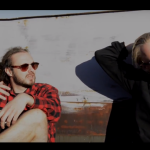 The documentary is made on a DIY basis. How did that influence the concrete production process? How many people were involved in working on it? And how did you coordinate in order to get everything done? How did you get the (money) resources and the necessary equipment?
The documentary is made on a DIY basis. How did that influence the concrete production process? How many people were involved in working on it? And how did you coordinate in order to get everything done? How did you get the (money) resources and the necessary equipment?
The DIY aspect played a part in everything in the production process, really: we had to deal with the equipment we were able to borrow from our circle of friends, which from time to time meant shooting with pretty shitty cameras for example and not having the necessary lighting equipment etc. But we had a strong mindset from the get-go that these technical handicaps are not the issue, as long as we succeed in portraying the people honestly and as they are. Along the process our “movie making ambitions” kind of woke up and from time to time we actually tried to shoot stuff in a way where it would be from a good angle with sufficient light and a clear sound, but when that wasn’t possible, we just said “fuck it” and shot anyway. We were basically a team of five, me plus four people on cameras. We didn’t really have cemented roles or assignments on the movie, but basically I was in charge of the logistics; scheduling and writing the interviews, planning out the timeline of the work, getting people informed that we’re making a movie, stuff like that, while the rest of the crew focused more on the technical side of the work; shooting, capturing audio, editing the film. But everything happened as a joint effort, we were really fixated on getting the movie done, so everyone just did what had to be done; sometimes the technical crew would participate more in the planning and in the “directorial“ work, sometimes I would be the one holding the camera or the recorder. It didn’t matter as long as we got shit done. DIY also meant that we had to guess a lot of what we were doing, since none of us had done a movie before or really educated themselves on the issue, so the modus operandi was pretty much “guess – fail – try again – get it somewhat right“. But that’s how you learn and we learned a hell of a lot during the process. One of the most important lessons we learned was the necessity of coordination and organization, which we had, especially in the beginning of the work, very little of. Luckily we picked upon the idea of planning shit out pretty quickly, but as we started, we had no clear idea on what we want to do, no thought-out plot line or structure to go after, no working schedule, just the overflowing attitude of “let’s make a fucking movie!“ I personally thought it was going to be a month or two of shooting, a month of editing and then the premiere. So the whole process presented itself to me as a three to four month deal. I had no clue it would take us almost two years to go from the first meeting to the release of the movie! A majority of the money involved in making the movie came from crowdfunding. We gave the people an option to fund the documentary by pre-ordering our T-shirts, DVD’s and tickets to the premiere in advance, and this brought us a bit short of 4000 euros, I think. So it was really affective and i wholeheartedly advice anyone interested in financing a DIY-movie to explore this method, since there are a lot of formats in which to do this, a lot of countries have their own crowdfunding-platforms (Finland has Mesenaatti.me) and there are also a lot of international platforms (Kickstarter, Indiegogo, Gofundme etc.), and it doesn’t tie you down to specific funders or their desires. We also received two grants, making us a total of 2000 euros, so the overall budget fort he movie was 6000 euros in total, but you can make these for cheaper also, especially if you decide to cut the movie yourself and not pay a professional editor fort he work, which was what we did.
I guess you had to limit down the number of bands which should be interviewed or portrayed. How difficult was it to decide for the one or the other band or band member? Which criteria were important here for you? Is there perhaps a band or individual that you personally miss? Were there maybe also bands or individuals that didn’t want to get interviewed?
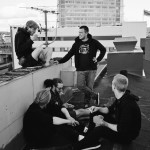
Katriina Pikkarainen: shooting break on rooftop of Tanssisali Lutakko during sessions with The Escapist, August 2015jpeg
We didn’t really limit down the number of interviews we filmed, since we did 33 sessions of bands and individual interviews. It wasn’t until our editor received the mountains of footage we had shot and went “OK, so what are we going to cut out?“ that we realized that we actually can’t fit all of this into a movie, not at least in a way where the structure would hold up as somewhat coherent. So then we had to start figuring out what needed to stay and what had to go, and with this our editor Sasu was a huge help, since he was the only one of us that had gone to an actual film school and knew something about structuring a movie and the arch of a story and he brought a lot of his own vision into it and worked outside of the script I had written a lot of the times, which worked great. When picking which part of the sessions would stay in the movie and which got cut out, I guess we were focusing mainly on three things: is the context of the story strictly connected to Jyväskylä, does it add to the storytelling and to the continuum of the movie and does it resonate any sort of feeling within us. We wanted a movie that is all about Jyväskylä, that is easy and hopefully interesting to follow and that transmits the feelings of the people in the scene, so those were the criteria. And sure, there’s tons of stuff I miss that got cut out! I would have for example loved to use the session we filmed with Tomi Marjamäki, the bass player of Rattus, since I love the band and I think they are one those Finnish bands that have really left their mark and affected the evolution of hardcore and punk worldwide, but unfortunately the interview was one of the first ones we shot and I had no idea what to ask in order to make the answers at least somewhat relevant to the topic of the movie, so we kind of ended up talking a bit outside of the actual issue and couldn’t in the end find a way to include Tomis stories to the overall story of the movie, which sucked, but I guess you got to be willing to kill a lot of your darlings when doing something like this. Basically the only time where a person we really wanted said no, was when Vote Vasko gracefully declined our invitation. Vote is not only a crucial part of the Jyväskylä history, but also a crucial part of punk and hardcore worldwide I think, him being the guy who released a lot of the early, classic Finnish hardcore punk records, including, but not limited to, the “Kytät on natsisikoja” seven inch split between Kaaos and Cagders (which later became Riistetyt) through his DIY-label and punk rock mail order business P.Tuotanto, which he still runs to this day, going on nearly four decades! Vote has also lived in Jyväskylä all of his life (I think) and organized most of the Jyväskylä punk shows in the 90’s, so it was clear that this person needs to be in the documentary. Unfortunately, Vote didn’t feel this way and didn’t want to be in front of a camera. He had nothing against the documentary and, from what I’ve gathered, he supported the idea fully, but didn’t really feel an interest in reminiscing his own works while being filmed. Luckily we got Vote included in the movie by asking people to share their memories on him and we also got to use a few cool photos of young Vote!
Do you have a particular memory to one of the interviews that is still memorable for you? Perhaps a certain place? A certain band or individual or a certain story?
We let people choose the locations of the shootings to their own liking, and from time to time this method brought on very romantic ideas on where shoot, but usually the most romantic and cool locations were also the ones that made us go ‘oh fuck…’ on a technical level. One of these occasions was the session we did with The Escapist on the rooftop of Tanssisali Lutakko. It was exiting as hell to climb on to the roof and admire the crazy cool view of Jyväskylä that opened all around us, but when we set up the recorder, we obviously noticed that the wind is a BIG problem. We decided to shoot anyway, since it was a really cool location, and it did turn out well in the end (we had to skip a few good parts because of the wind, but nothing major). The feeling of all of us standing on that rooftop on that beautiful late summer day doing exactly what we want, exactly the way we want to do it, was a feeling I think I’ll always remember very fondly.
The documentary displays many different people in front of the camera (punks, fanziners, organizers, bands, activists, police officers, etc.). I guess some answers or slots had to be cut down. What is your favorite anecdote that didn’t end up in the documentary?
One thing comes to mind which isn’t really an anecdote, but a whole interview we had to cut out, which kind of broke my heart. Through making this documentary I got to know a great man by the name of Juice Kokora, whom I had no pre-existent knowledge of, but who had especially in the 80’s played a huge part in the Jyväskylä scene, playing in bands, organizing shows and being an all-around good guy of the scene. A lot of the people we interviewed to the early section of the movie remember Juice very fondly, some of them even naming him as the “Godfather of Jyväskylä punk”. I really wanted to get Juice involved in the documentary, which turned out not to be the simplest thing. I say this with nothing but love and respect and all the best in mind, but Juice has had a somewhat rough “rock ‘n’ roll”-life, you could say, and I guess this has partly resulted in him being a bit of a loner these days, a person who doesn’t get out that much and who has somewhat issues with conversating with people, especially people he doesn’t know and especially when there are cameras involved. 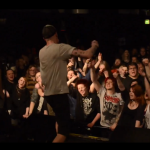 I didn’t have to twist his arm to get him to participate, but we did need to have a few discussions on why it is important for him to take part before him saying yes. We filmed him on the banks of Tourujoki one early day of fall and it was a beautiful setting and I really digged the atmosphere and Juices aura. He was nervous as fuck and stated not feeling comfortable after every answer, but I thought it was great that we get to film this giant of a man as he is, as a nervous legend who doesn’t feel comfortable talking about himself. We actually shot the interview for a second time at his apartment later on to dig more deeply into some questions and themes, and had the idea of combining these two sessions in the film. But, as it turned out, we couldn’t find a way to work the story of Juice into the overall plot line and to the one hour time limit of the movie. It was sad to see it go, ‘cos I felt like we captured something pretty unique when we talked with Juice, and I would have loved to use him in the movie if the chronology and the linearity had allowed it. But, luckily we have the DVD extras for these kinds of gems!
I didn’t have to twist his arm to get him to participate, but we did need to have a few discussions on why it is important for him to take part before him saying yes. We filmed him on the banks of Tourujoki one early day of fall and it was a beautiful setting and I really digged the atmosphere and Juices aura. He was nervous as fuck and stated not feeling comfortable after every answer, but I thought it was great that we get to film this giant of a man as he is, as a nervous legend who doesn’t feel comfortable talking about himself. We actually shot the interview for a second time at his apartment later on to dig more deeply into some questions and themes, and had the idea of combining these two sessions in the film. But, as it turned out, we couldn’t find a way to work the story of Juice into the overall plot line and to the one hour time limit of the movie. It was sad to see it go, ‘cos I felt like we captured something pretty unique when we talked with Juice, and I would have loved to use him in the movie if the chronology and the linearity had allowed it. But, luckily we have the DVD extras for these kinds of gems!
How did you came to your own catalogue of questions? It is interesting that one never hears a question in the documentary. Everything is completely centered around the bands or individuals talking. The posed questions could only be infered from context (which totally works by the way). But: How did you came to this idea to tell a Jyväskylä-punk-story?
It was very clear from the beginning that we’re not going to use a narrator or be seen or heard in any way in the movie, since like you said, the bands and the individuals were the center. We wanted to fade ourselves out of the outcome totally and create a relaxed, natural atmosphere of good friends reminiscing. This wasn’t really all that tricky to pull off, all I did before we turned on the cameras was briefly explain the method of the interviews (no questions will be audible or readable) and people got it straight up. I had written down a list of questions for each interview and gave them to the people being interviewed beforehand, but pointed out to everyone that these are not meant to be taken as a strict question-answer-formulas, but that these are more of a loose structure on the things we might talk about. A lot of the times the questions came up as an result of something the interviewee said, as a result of riffing back and forth, like in a natural conversation. I was happy with the results and I’m glad to hear you think it worked too!
The fact that you interviewd a police officer from Jyväskylä is interesting. Was it easy to get to talk to him? How did the interview went behind the scenes? It is rather short, but were there more issues that you talked about?
It was, he was actually a really cool guy, I felt! I don’t have as strong of a “A.C.A.B” mentality as I did some years back, eventhough I realize the police as an institution is something to be critical of and often with very valid reasons. The section is short, ‘cos like with every interview, we couldn’t just paste together all the good anecdotes, but had to think about the overall story and the continuum of the movie, how the parts work together, and therefore had to cut a lot of the material that didn’t really follow the structure. We talked a lot about the Reclaim The Streets party held every summer in opposition of the annual Neste Rally in our city, and it was really interesting to get a peek into how the whole thing presents itself to an officer of the law. It didn’t feel like he talked to us as a representative of the Jyväskylä police force, but as himself, when he told us that even though the party is illegal and therefore from his point of view cannot be condoned, he totally gets why it exists and that he wants to always live in a world where people are able to protest in such a way. He talked a lot about him being OK with punks and other people calling them ‘pigs’ and ‘bastards’, ‘cos he felt that the power and the possibility to criticize those in power and control should always be left to the people. Now, I know that some might read this just as a calculated promotional statement on behalf of the Jyväskylä police force, but it genuinely felt like he was just voicing his own personal opinion as a human being. He also talked about how pissed off he was as a fourth grader when he brought a Dead Kennedys record to his schools juke box jury and his teacher refused to play it, which was a cool anecdote! But I think the funniest part of the interview happened after we turned the cameras off (as they often did): when we were shaking hands and expressing thank-yous, he got a puzzled look on his face and went: “I didn’t actually know that punk still exist as such a big thing. I think it’s amazing that people still listen to and play punk, ‘cos let’s face it, the music always fucking sucked!” 😀
On the DVD there will be some specials or extras also in a subtitled form for English speakers. What is the plan to get as well the DVD done? And what will the whole thing look like?
The plan is to get the DVD out early 2017. We will most likely press somewhere between 300 – 500 copies, but we haven’t really decided on that yet. “Early” is also somewhat of an elastic concept when writing this (December 2016), since we’re aiming to get the special features of the release done in a way that makes us as pleased as the movie itself, and just like with the movie, we don’t really have a clear vision on what and how we need to do, so we’re figuring out the schedules as the work with the extra features progresses. I would say February, or at latest, March is somewhat a realistic month of release for the DVD. We’ll keep people posted on the release and the pricing and how to order on our Facebook page as we know more! The DVD in itself will feature (besides the movie, of course) the making of-interviews from our five-member crew, a feature from the premiere of the documentary, footage from a few trips to film festivals in Finland we did with the movie and footage from the questions & answers-sessions following the festival-screenings, a bloober reel (obviously!) and of course, a lot of the deleted material from the movie, all done with the same affection and effort as the movie itself and all subtitled!
You yourself were a member of a band from Jyväskylä („Antiklimax) that doesn’t appear in the documentary, although your are among those who played concerts also abroad (Berlin, Halle, Leipzig). Was it totally clear to you that your own band will not be displayed in the documentary?
Yes, it was a conscious decision to leave my own bands out of the documentary (even though there would have been some fun stories to tell there also). I thought about it, and it kind of felt like an ego trip to start going through your own bands and I didn’t really want to do that. I knew the reality was that we’re not going to be able to fit every band that has ever played punk in Jyväskylä into the documentary anyhow, so my own bands kind of just fell into that category. It didn’t harm the overall storyline to leave my bands out of it and it served the function of us fading ourselves, the makers, out of the documentary completely. Even though my bands are not included, I do get a kick out of seeing footage and hearing my peers talk about events and places in the documentary that I have been strongly affiliated with, for an example the section of the movie that covers the outskirts of Jyväskylä, the scene and shows in the smaller towns around the city is really close to my heart, ‘cos me and my friends were the ones putting up the shows in one of the towns, and it warms me deeply to hear those shows being reminisced. We chose to put that into the documentary despite its personal connection, ‘cos the “outskirts scene” was way more important to the people growing up in this area than any one particular band. I still didn’t want to have a personal connection to it on film, so when people were talking about me putting up the shows, I asked them to make it more ambiguous in their speech, which was really one of the few times I actually “directed” people during the interviews.
 The documentary is out since Oct 15th 2016. What are the next plans for ‘Jyväskylän Meininki’? I heard that you had planned some screenings in Estonia as well? Wouldn’t it be possible to show the documentary also in other places abroad?
The documentary is out since Oct 15th 2016. What are the next plans for ‘Jyväskylän Meininki’? I heard that you had planned some screenings in Estonia as well? Wouldn’t it be possible to show the documentary also in other places abroad?
Yeah, we have been talking about a screening in Estonia, and we’ll see if we can get anything going in Germany also! There has been some conversations on getting the documentary shown in Los Angeles too and these are all relatively easy to pull off, even though they might sound like big ideas to some. We have a subtitled version of the movie in a HD-file that we can sent to the people organizing a screening in a bar, a squat or any venue of choise basically, and all the organizer needs is a screen, a laptop, a projector and voilà! The screenings in Finland and abroad (if you don’t count the film festivals) are done the same way DIY punk shows are done all around the globe, and since punk is a worldwide conspiracy of people helping people, we are confident that we can find individuals and groups that can and want to help in getting the movie and its message out there! If you wish to participate, you can contact us at jyvaskylanmeininki@gmail.com, and we can make it happen.
Mikko, thank you very much for all the great and detailed answers!
Thanks a lot for the interview, we hope everyone who’s interested gets a chance a to see the movie and we hope you like it! Go in peace and make the most of your life the way you see fit!
• Interviewtext: Mikko + Benni
• Contact (also for the DVD): jyvaskylanmeininki@gmail.com
• Website: facebook.com/jyvaskylanmeininki

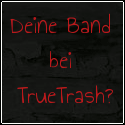


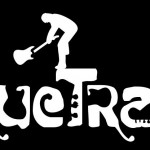 Dieser Beitrag wurde am
Dieser Beitrag wurde am 